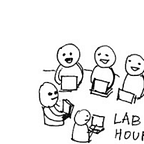Blog post by Liza St. James
On the first day of Code Words this past Sunday, July 29, 2018, students and teachers gathered for brunch in the courtyard followed by introductions in the SFPC classroom. Program organizer Nick Montfort asked what languages we all spoke, read, were working in, and we learned that in addition to Python 3, we’ll have a wide variety of languages in the room.
Next we went over codes of conduct for the week. Nick and Taeyoon explained that our workshop is a space for exploration, trying things out, rather than polishing and publishing — that the work we’ll be discussing is work that will be made here over the course of our week together. We went over the daily class schedule (reading, discussion of student work, a short break, and then a lesson) as well as what discussion and workshop would entail. Each session, Monday through Thursday, would include an hour-long discussion of student work in which five students would present work created this week for five minutes each. These presentations would be followed by a short group workshop. (Students are encouraged to present at least once in one session Monday through Thursday, and all are encouraged to present in the final reading on Friday.)
Nick said that his aim is for the course to have “low stairs and a high ceiling,” using the metaphor of a guitar with just a few chords. He explained that the goal is to have an easy on-ramp for beginners to programming with room for those who are more experienced to go further. He introduced our TA Todd Anderson, and joked that we’ll all be able to make some music on our little five string guitar, even the Claptons in the room.
Then Nick gave a reading from Autopia, 2x6 [The Two,] “Duels — Duets,” “Taroko Gorge,” and The Truelist before launching into a discussion. He mentioned a parable of the ant making intricate patterns on a beach, and how someone might attribute that complexity to the ant when in fact the ant is merely following pheromones and the complexity resides in the beach. We then returned to the texts Nick had just read and attempted to identify the “beach” in them. One student ventured that Nick — or the corpus — was the beach, another student suggested that the reader, with the various contexts they bring to the poem was the beach.
Next we played “Question and Answer,” a collaborative automatic writing exercise along the lines of the “exquisite corpse” parlor games originally developed by the Surrealists to gain access to the unconscious. The game involved each student writing a question as quickly as possible, and then folding the paper over and passing it to another student for an answer. The second student answered as quickly as possible — without reading the question — and handed the question-answer pair to a third student to read aloud to the group. The exercise yielded both some funny and philosophical results.
Then we took a quick break. Nick’s Commodore 64 was available for use in the kitchen area.
After the break we launched into some Python 3 exercises. (Nick had asked us, prior to the session, to install Anaconda, a true text editor such as Atom, and the Python library TextBlob.) For Sunday’s exercises we used our Juypter notebooks in Anaconda to modify the programs on the Memory Slam site. We focused on Love Letters — Christopher Strachey, Stochastic Texts — Theo Lutz, and House of Dust — Allison Knowles and James Tenney, and discussed things like what sort of balance between variety and repetition is best for a generator, corpus size, sentence structures and parts of speech, and went over the Python codes a bit. Then we worked individually to modify one of the codes and shared the results of our work by reading aloud from the modified versions we developed in class.
Our prompt for Monday was to create our own tiny computer-generated booklet using (1) a short, self-contained Python program of no more than 66 lines (80 characters/line); (2) a single printed sheet, US letter size, which can be printed single-sided or double-sided and made into a booklet using a pamphlet stitch, the 8-page zine cut-and-fold technique, or any other means. We were asked to make at least six copies to bring to class so that we could look at them all together and trade with one another on Monday. Nick had brought a variety of booklets other groups had made, and we spent the last few minutes of the session reading them.
